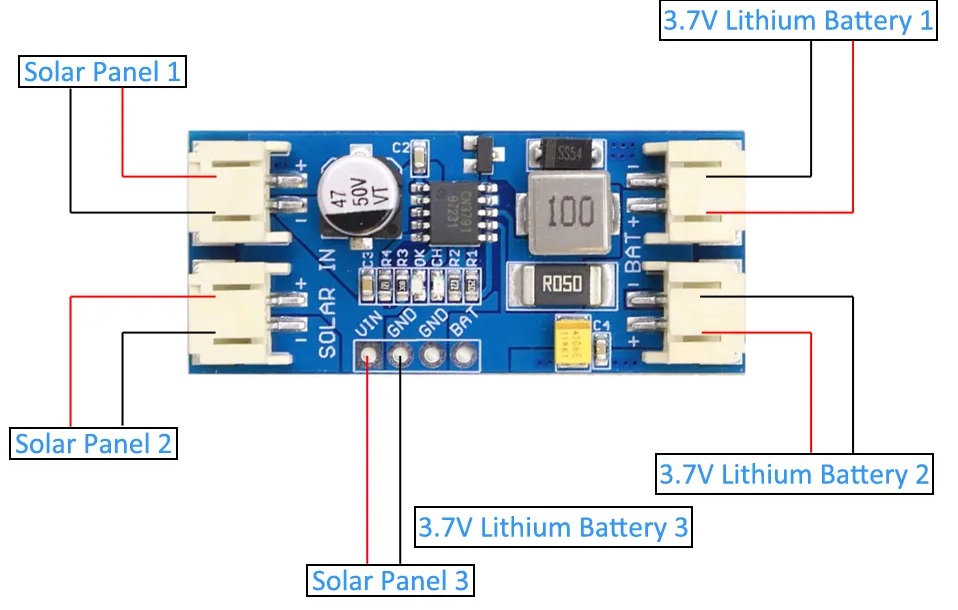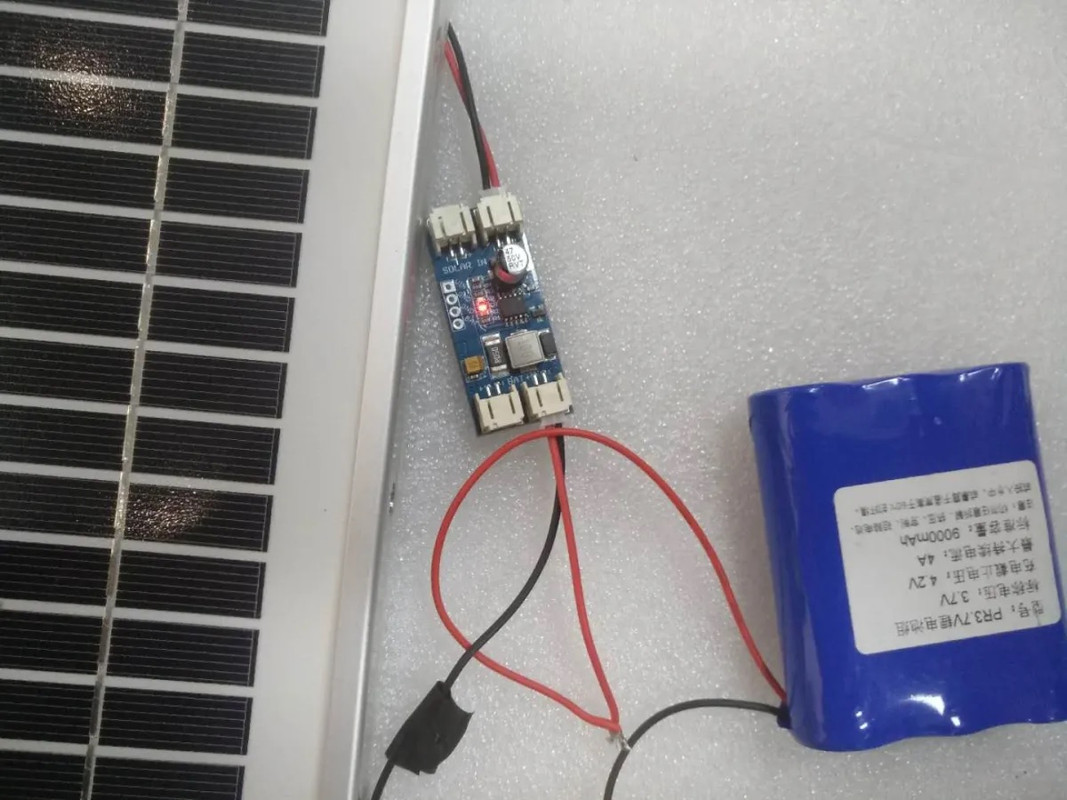Out Of Stock
Description
The CN3791 is a compact and efficient module designed for charging single-cell lithium batteries using solar power. It features an MPPT algorithm for maximum power output, can provide a charging current of up to 2A, and uses high-frequency PWM switching for stable and efficient charging. The module has complete charge management features, including a float charge circuit for deeply discharged batteries, automatic charging, and LED indicators for charging status. It also has built-in protection circuits for battery overvoltage and can operate in a wide temperature range. The module has a compact size of 45mm x 20mm x 9.5mm and uses 2-pin JST connectors for easy integration into various projects.
Package Includes:
- 1 x CN3791 Charging 6V MPPT Solar Power Panels Lithium Battery Charging Module
- 2 x 2-pin JST Connector
Features:
- Solar panel maximum power point tracking: The module uses an MPPT algorithm to track the maximum power point of the connected solar panel, ensuring efficient power output.
- Complete charge management for single-cell lithium batteries: The module is designed for charging single-cell lithium batteries and has complete charge management features.
- Charge current up to 2A: The module can provide a charging current of up to 2A, allowing for fast charging of the connected lithium battery.
- PWM switching frequency: The module uses high-frequency PWM switching at 300KHz, ensuring stable and efficient charging.
- Charge voltage: The module can charge lithium batteries up to a nominal voltage of 3.7V, with a full charge voltage of 4.2V.
- Float charge circuit for deeply discharged batteries: The module features a float charge circuit that can charge deeply discharged batteries without causing damage.
- Automatic charging: The module has automatic charging capabilities, making it easy to use and operate.
- Charge status and charge end status indication: The module has LED indicators that show the charging status and when the charging process is complete.
- Soft start: The module has a soft start feature that prevents high inrush currents during the charging process.
- Battery overvoltage protection: The module has built-in protection circuits that prevent overvoltage conditions, ensuring the safety of the connected lithium battery.
- Wide working temperature range: The module can operate in temperatures ranging from -40°C to +85°C.
- Compact size: The module has a compact size of 45mm x 20mm x 9.5mm, making it easy to integrate into various projects.
Description:
The CN3791 is a highly efficient module designed to charge single-cell lithium batteries using solar power. It features an MPPT algorithm that tracks the maximum power point of the connected solar panel, ensuring that the module operates at its maximum efficiency. This helps to increase the overall power output of the module, which is particularly useful in low-light conditions. The module has complete charge management features, including a float charge circuit for deeply discharged batteries, automatic charging, and LED indicators for charging status. The float charge circuit ensures that deeply discharged batteries can be charged safely, without causing any damage. The automatic charging feature makes the module easy to use and operate, as it will start charging the battery automatically when it is connected to a power source. The module is capable of providing a charging current of up to 2A, which allows for fast charging of the connected lithium battery. It uses high-frequency PWM switching at 300KHz, which ensures that the charging process is stable and efficient. This also helps to minimize power loss during the charging process, which in turn helps to increase the overall efficiency of the module. The module has built-in protection circuits that prevent battery overvoltage, ensuring that the connected lithium battery is not damaged during the charging process. The LED indicators on the module provide a clear indication of the charging status and when the charging process is complete. The module also has a soft start feature that prevents high inrush currents during the charging process, which can be useful in certain applications.
Principle of Work:
The CN3791 Charging 3.7V Lithium Battery Solar Power Panel Module works on the principle of Maximum Power Point Tracking (MPPT). MPPT is a technique used to extract maximum power from a solar panel by continuously adjusting the load impedance. When the solar panel is exposed to sunlight, it generates a voltage and current that varies with the amount of sunlight received. The CN3791 module uses an MPPT algorithm to track the maximum power point of the solar panel, which is the point where the panel can produce the maximum amount of power. The module then adjusts the load impedance to match the maximum power point of the panel, allowing it to operate at its maximum efficiency. Once the maximum power point of the solar panel is determined, the module uses a high-frequency PWM switching at 300KHz to charge the connected lithium battery. The module has complete charge management features, including a float charge circuit for deeply discharged batteries, automatic charging, and LED indicators for charging status. During the charging process, the module uses the PWM switching to maintain a stable and efficient charging current, which can reach up to 2A. The float charge circuit ensures that deeply discharged batteries can be charged safely without causing any damage. The LED indicators on the module provide a clear indication of the charging status and when the charging process is complete. The module also has built-in protection circuits that prevent battery overvoltage, ensuring that the connected lithium battery is not damaged during the charging process. The soft start feature prevents high inrush currents during the charging process, which can be useful in certain applications.
Pinout of the Module:

- VIN: This is the input pin for the solar panel. It is connected to the positive terminal of the solar panel.
- GND: This is the ground pin for the solar panel. It is connected to the negative terminal of the solar panel.
- BAT: This is the output pin for the lithium battery. It is connected to the positive terminal of the battery.
- GND: This is the ground pin for the lithium battery. It is connected to the negative terminal of the battery.
- OUT: This is the output pin for the module. It provides a regulated output voltage that can be used to power other devices.
- LED: This is the indicator pin for the module. It provides an LED signal that shows the status of the charging process.
- JST Solar Panel 1,2: its input + GND just
- JST Battery 1,2: provides a regulated output voltage
The module also has two-pin JST connectors (or PH2.0) that can be used to connect the solar panel and lithium battery to the module.
It is important to note that proper polarity must be observed when connecting the solar panel and lithium battery to the module. The VIN and BAT pins must be connected to the positive terminals of the solar panel and lithium battery, respectively, while the GND pins must be connected to the negative terminals. Failure to observe the correct polarity may result in damage to the module and connected devices.
Applications:
- Solar-powered battery chargers for smartphones, tablets, and other portable devices.
- Portable solar power systems for camping, hiking, and other outdoor activities.
- Solar-powered lighting systems for gardens, pathways, and other outdoor areas.
- Remote monitoring and telemetry systems powered by solar panels.
- Solar-powered water pumps and irrigation systems.
- Solar-powered weather stations and environmental monitoring systems.
- Solar-powered electric fence chargers.
- Solar-powered remote sensing and data acquisition systems.
The module is compact and easy to use, making it an ideal choice for DIY solar projects and hobbyist applications. It is also suitable for use in commercial and industrial applications where reliable solar power is required.
Circuit:

This is a small circuit for charging a li-ion pack using a solar panel through the module just connect the two 3 components together using JST connecter as in the pinout
Library:
No library is needed
Code:
No code needed
Technical Details:
- Input voltage: 4.4V - 6V DC
- Maximum input power: 10W
- Charging current: Up to 2A
- Charge voltage: 4.2V +/- 1%
- Float charge voltage: 4.18V +/- 1%
- Charge termination current: 0.1A
- Maximum efficiency: 95%
- PWM switching frequency: 300kHz
- Operating temperature: -40°C to 85°C
- Storage temperature: -40°C to 125°C
- Dimensions: 45mm x 20mm x 9.5mm
- Weight: 7.3g
Resources:
Comparisons:
Both the CN3791 Charging 6V MPPT Solar Power Panels Lithium Battery Charging Module and the Solar Lipo Charger v1.0 DFRobot (3.7V) are designed for charging single-cell lithium-ion batteries from solar panels. However, there are some key differences between the two modules:
- Input voltage range: The CN3791 module has a slightly wider input voltage range of 4.4V - 6V DC, while the Solar Lipo Charger v1.0 DFRobot has an input voltage range of 4.4V - 7V DC.
- Charging current: The CN3791 module supports charging currents of up to 2A, while the Solar Lipo Charger v1.0 DFRobot supports charging currents of up to 500mA.
- Charge termination current: The CN3791 module has a charge termination current of 0.1A, while the Solar Lipo Charger v1.0 DFRobot has a charge termination current of 45mA.
- Maximum efficiency: The CN3791 module has a maximum efficiency of 95%, while the Solar Lipo Charger v1.0 DFRobot has a maximum efficiency of 80%.
- Output voltage: The CN3791 module is designed for charging 3.7V nominal lithium-ion batteries, while the Solar Lipo Charger v1.0 DFRobot is designed for charging 3.7V lithium polymer batteries.